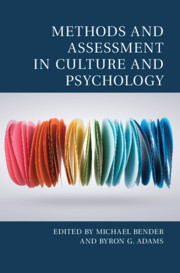Book contents
- Methods and Assessment in Culture and Psychology
- Culture and Psychology
- Methods and Assessment in Culture and Psychology
- Copyright page
- Dedication
- Additional material
- Contents
- Figures
- Tables
- Contributors
- Foreword
- 1 Introduction to Methods and Assessment in Culture and Psychology
- Part 1 Acculturation and Identity
- Part 2 Individual Differences across Cultures
- Part 3 Culture and Assessment
- 12 Psychological Assessment In and Over Time: Challenges of Assessing Psychological Constructs and Processes in Cultural Dynamics
- 13 Priming Culture(s): How Theories and Methods Inspire Each Other
- 14 The Evolution of Multigroup Comparison Testing across Culture: Past, Present, and Future Perspectives
- 15 How Far Can Measurement Be Culture-Free?
- Index
- References
12 - Psychological Assessment In and Over Time: Challenges of Assessing Psychological Constructs and Processes in Cultural Dynamics
from Part 3 - Culture and Assessment
Published online by Cambridge University Press: 21 January 2021
- Methods and Assessment in Culture and Psychology
- Culture and Psychology
- Methods and Assessment in Culture and Psychology
- Copyright page
- Dedication
- Additional material
- Contents
- Figures
- Tables
- Contributors
- Foreword
- 1 Introduction to Methods and Assessment in Culture and Psychology
- Part 1 Acculturation and Identity
- Part 2 Individual Differences across Cultures
- Part 3 Culture and Assessment
- 12 Psychological Assessment In and Over Time: Challenges of Assessing Psychological Constructs and Processes in Cultural Dynamics
- 13 Priming Culture(s): How Theories and Methods Inspire Each Other
- 14 The Evolution of Multigroup Comparison Testing across Culture: Past, Present, and Future Perspectives
- 15 How Far Can Measurement Be Culture-Free?
- Index
- References
Summary
Cross-cultural methodology has made significant progress. Yet, research methodology is in part a response to the challenges posed by research agendas given the intellectual and technological resources available at the time. Just as the contemporary achievements in cross-cultural research methodology are a response to the necessity of the synchronic cross-cultural research in the globalizing world of the late 20th century, the changing cultural landscape of the early 21st century demands a diachronic research agenda – cross-temporal research of psychological phenomena in human populations. Meaning equivalence and autocorrelation are highlighted as major challenges to both synchronic and diachronic approaches in cross-cultural psychology. Researchers need to meet these challenges in the future.
Keywords
- Type
- Chapter
- Information
- Methods and Assessment in Culture and Psychology , pp. 255 - 270Publisher: Cambridge University PressPrint publication year: 2021



